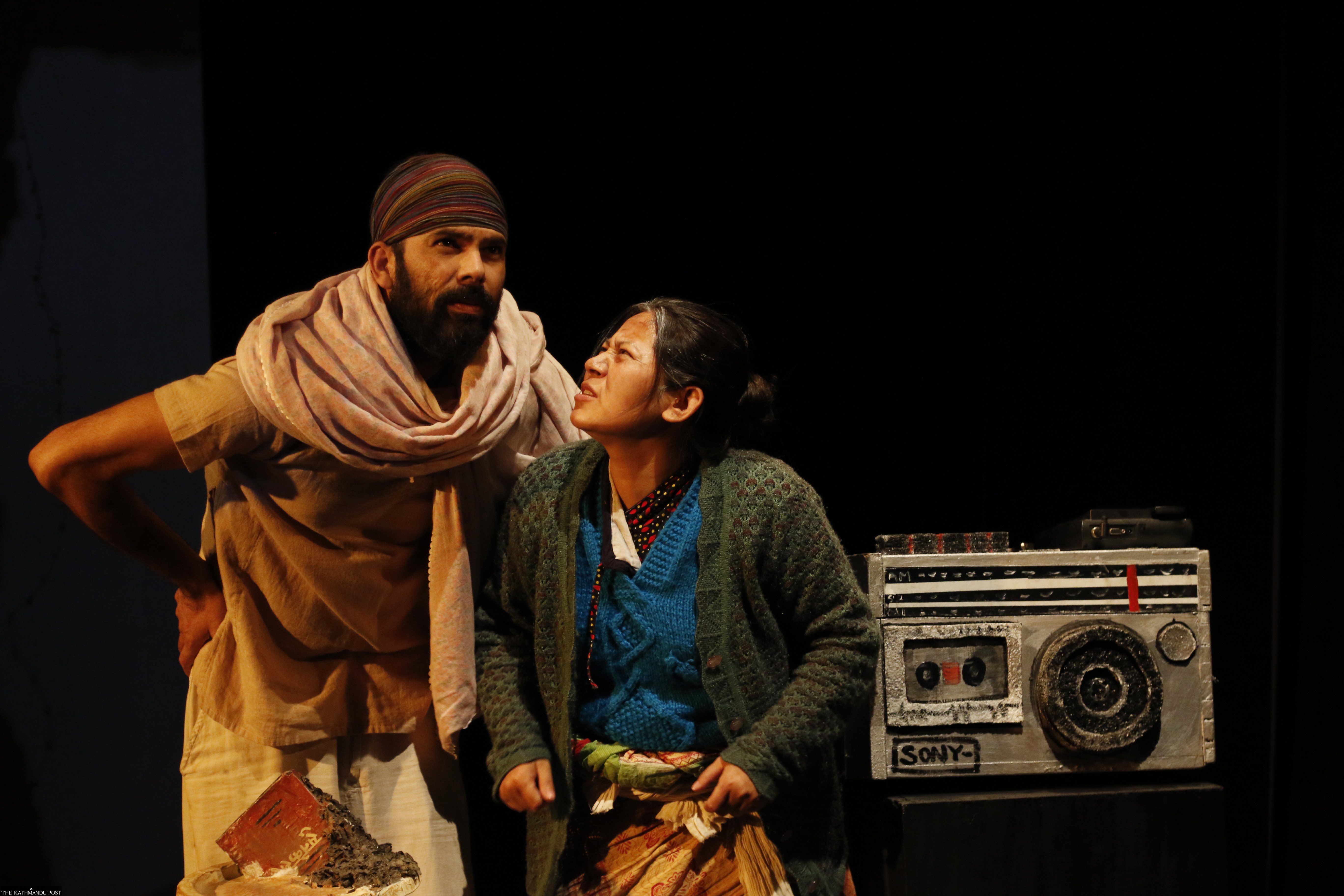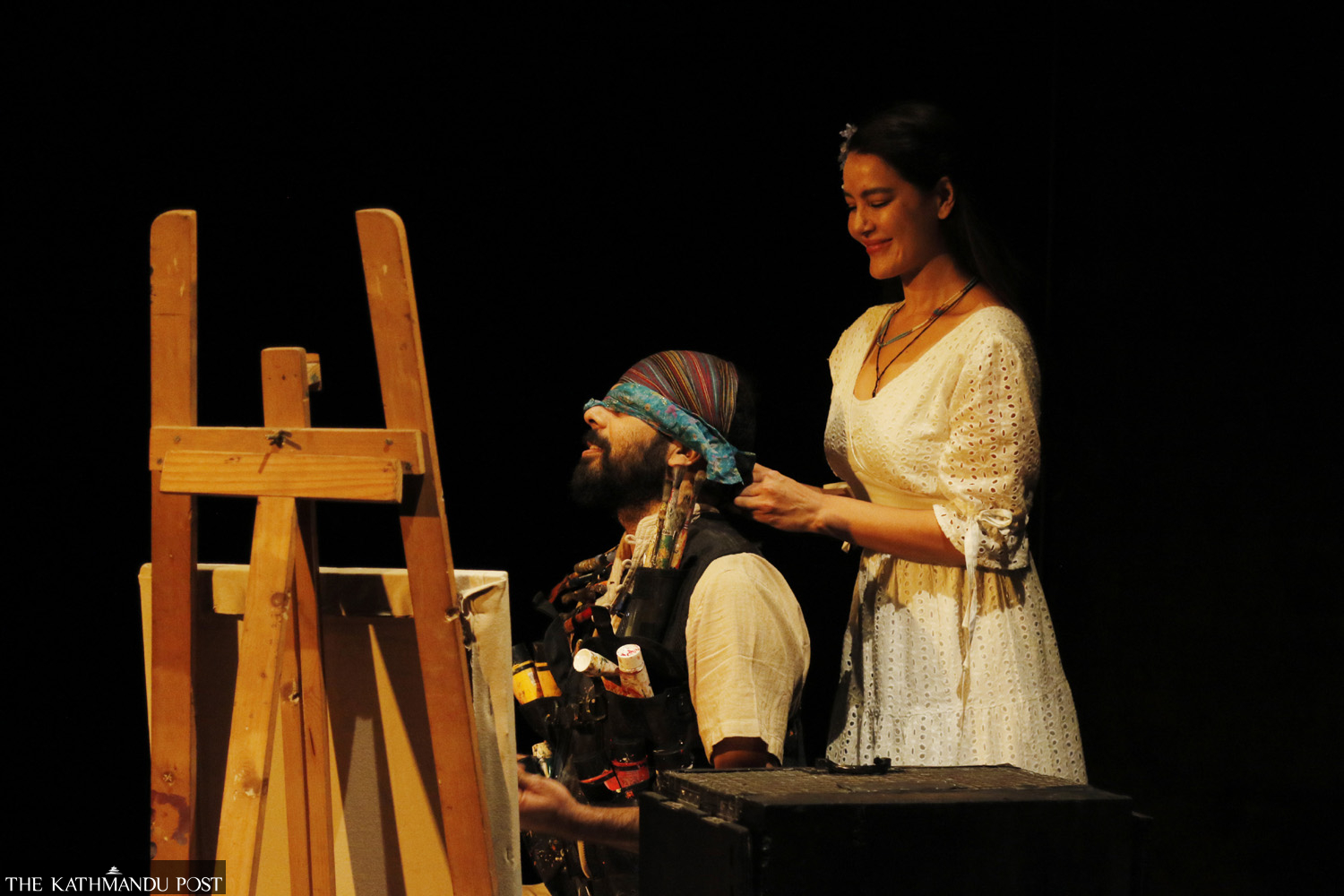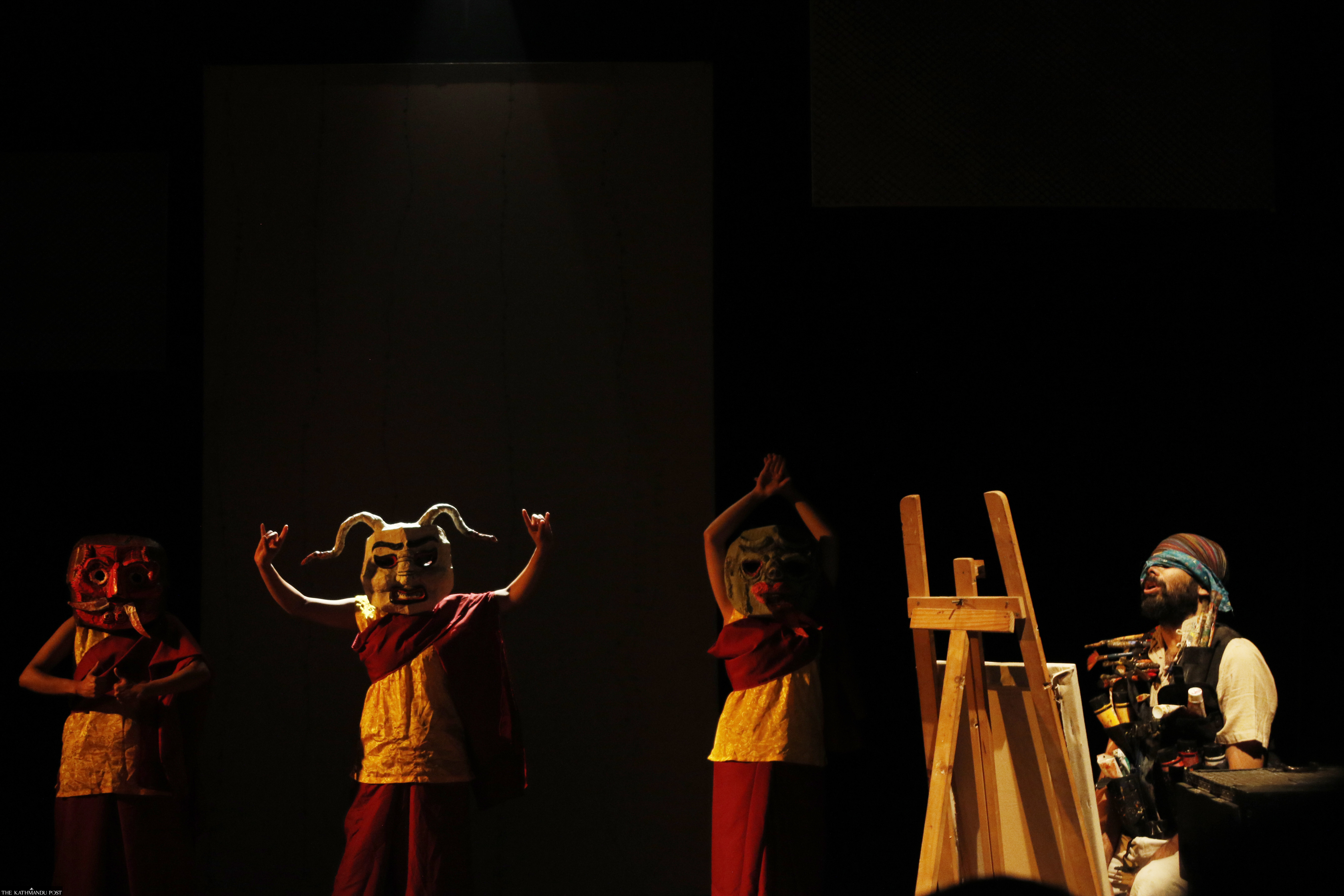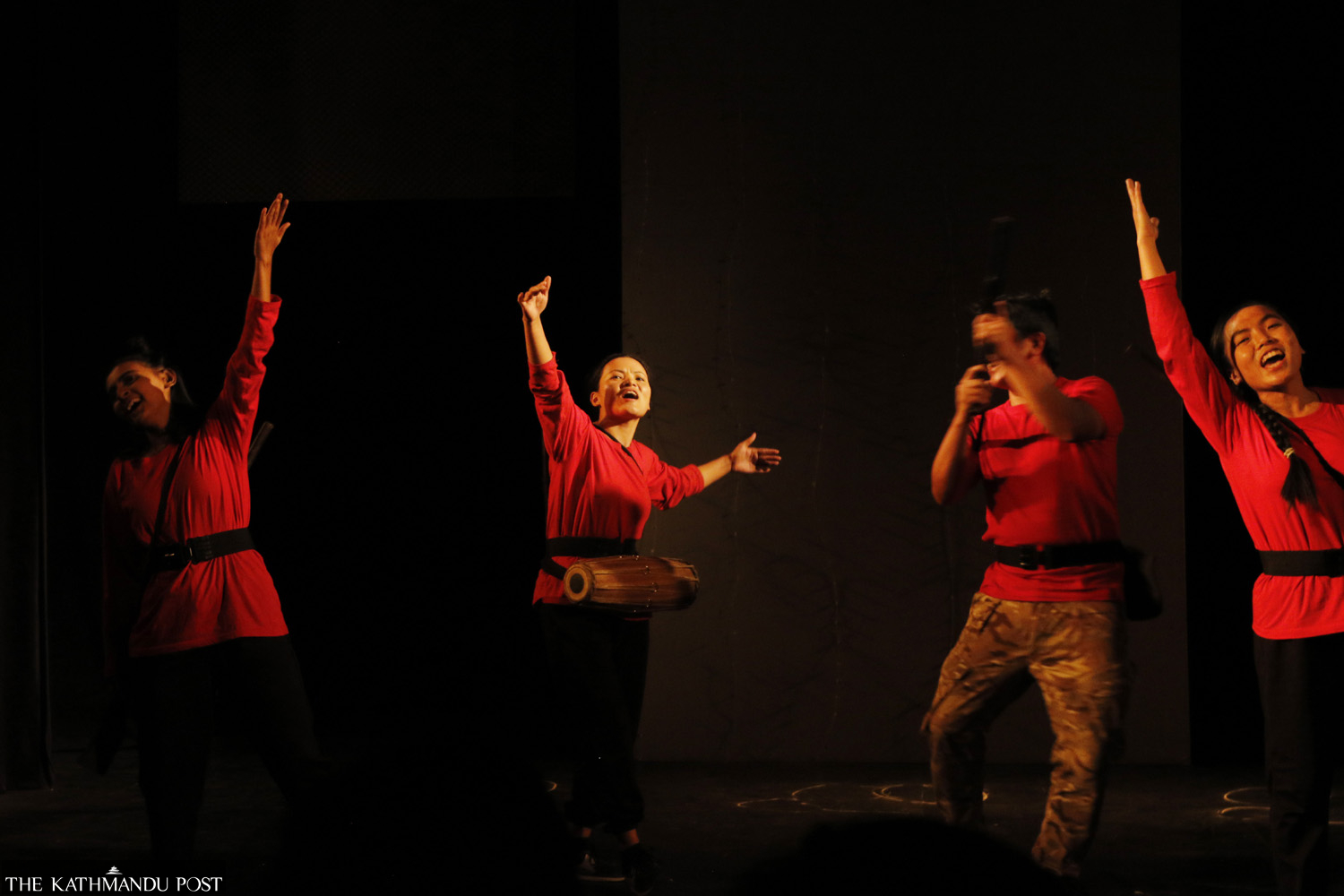Culture & Lifestyle
‘Palpasa Cafe’ from a new vantage point
The dramatisation by Theatre Village Nepal offers new things to the audience but they are not all good.
Shranup Tandukar
When steel plates are thrown from the sides of the stage by unseen hands onto the centre of the stage, there is chaos everywhere. Beginning with a few plates being hurled, this frenziness increases in intensity as more plates are thrown, and the whole stage is covered with plates. The plates are airborne for a brief moment and come crashing down with a terrible noise, like the sounds of guns being fired.
This metaphorical representation of the violence that occurred during the 'people’s war' from 1996 to 2006 in Nepal is one of the most powerful scenes in the theatrical adaptation of ‘Palpasa Cafe’ being staged in Mandala Theatre, Thapagaun. Directed by Bimal Subedi and co-directed by Dilip Ranabhat, the play was dramatised by Suraj Subedi and presented by Theatre Village Nepal.
'Palpasa Cafe', written by Narayan Wagle and first published in 2005, chronicles the journey of protagonist Drishya, a painter, into the western villages of Nepal during the height of the civil war. Against the backdrop of the violence of war, Drishya also falls in love with Palpasa, an aspiring documentary filmmaker.
While all of the characters and some of the major plot points in the play are derived from the original novel, the play sometimes deviates from the original story and emphasises different issues. The original novel was written when the civil war was still ongoing, but as the play has been written sixteen years after the end of the war, dramatist Suraj has instead chosen to focus on the long-term impact of the war. The plight of the families of missing persons during the war has taken centre stage in the play, an issue which is unfortunately still relevant.

The beginning of the play starts with two masked figures, a fox and a mouse, exchanging their masks in silence. As the audience observes this unusual action in rapt attention, the distinct style of director Bimal—which focuses on the subtle allusions and alluring metaphors—becomes clear.
The intention of the dramatist and director to expand upon the themes of the novel is commendable. But, the use of heavy metaphors, cryptic dialogues, and subtle symbolism sometimes obscure their intentions. Most of the scenes in the play, unfortunately, become a complete hit-or-miss; for example, the scene with the chaotic hurling of plates is powerful and resonant, while the opening scene with the exchanging of masks is simply confusing.
Similar to the novel, Drishya (played by Bimal Subedi) meets Palpasa (played by Shristi Shrestha) in a restaurant in Goa. With Drishya’s published compilation of his paintings as a focal point of discussion, the two Nepalis in a foreign land quickly become close but part their ways just as soon. The characteristics and mannerisms of Drishya and Palpasa are given justice by Bimal and Shrestha, but the chemistry between the two potential lovers doesn’t feel as real.
Back in Nepal, Drishya, in search of a book that will help him find a fitting colour palette for his gallery walls, meets an old grandmother (played by Sangeeta Thapa) in her aged but well-preserved house. We are first introduced to Thapa who is busy weaving a ball of yarn, bright-red and the colour of blood. Drishya and the grandmother soon become fast friends, and Drishya even convinces her to dance to her favourite old tune.

The character of the old grandmother, who is just a side character in the novel, becomes an important figure in the play. Instead of being simply the grandmother of Palpasa, she is given a poignant additional backstory as one of the people still searching for their disappeared loved ones. At the end of the scene where she meets Drishya, both turn towards the audience and deliver passionate soliloquies. “Euta manche tesai kaha haraucha (How does someone simply go missing?),” they ask the audience.
Another important side character is Siddhartha (played by Dipesh Rai), an old college friend of Drishya. Siddhartha has followed the path of a revolutionary and is now a staunch maoist. Since Drishya is reproachful of maoists because of their violence against innocent people, he and Siddhartha have a heated discussion about their own ideals. Both the actors, Bimal and Rai, pull off the verbal conflict convincingly. In the end, Siddhartha challenges Drishya to view the real Nepal at the ground level and understand why the Maoists are waging the war the way they are.
As Drishya makes his way into the hinterlands of western Nepal, the tales of youthful Maoist cadres and Nepal Police officers come to light. Young children and teenagers are persuaded to join the revolution, leaving their parents behind to fend for themselves.
Throughout the play, violence and conflict, a common occurrence during the 'people’s war', is viewed from an oblique perspective. By focusing on the effect of the war on the naive and innocent youths, director Bimal has chosen to portray the war in metaphorical terms without showing direct physical violence.

In one scene, a young girl (played by Zenny Sunuwar) comes onto the stage and starts reciting the common nursery rhyme: Kukhuri ka basi bhat kha. During the questioning parts of the rhyme, she takes out a toy gun and points it at the audience threateningly. Soon, she joins the Maoist forces, and her group comes across a contingent of Nepal Police officers and instead of a violent confrontation, the two groups start a song battle. “Gau gau bata utha, basti basti bata utha,” sing the Maoists, while the police retort, “Rato ra candra surya, jhangi nisana hamro.”
In the novel, the effects of the war are devastating, real, and profound: Drishya gets caught in a crossfire between the Maoists and Nepali Police and almost gets shot himself; he meets grief-stricken and broken parents of his close childhood friend, who became a Nepal Police officer and died in a battle; he reunites with Palpasa on a bus ride back to Kathmandu, but Palpasa dies in a bus explosion, which he luckily survives. All of these events, which show first-hand experience of the war and its effects, are omitted from the play and are only referenced in dialogues between the characters. Instead, the play contains allusions to the violence and conflict in the war through songs, performative art, and dialogues. Unfortunately, the decision to tiptoe around the effects of the war in such subtle terms only makes the play less impactful than its source.
However, the play’s focus on the theme of missing persons of the 'people’s war' is intensely resonant. Thapa’s portrayal of the old grandmother is compelling. In the final scene, Thapa slowly moves from one side of the stage to the other, weaving a white ball of yarn as her narration questions exactly how a whole person can go missing without anyone noticing. The pain and hurt of the families who lost their loved ones and live a life shrouded in mystery and confusion is aptly conveyed by this scene.

The legacy of ‘Palpasa Cafe’ is a difficult one to either imitate or supersede, and rather than trying such a formidable task, the makers behind the ‘Palpasa Cafe’ play have attempted to focus on their own interpretations, which is laudable.
But while the play does give something new to the audience, it is riddled with scenes that are either completely captivating or utterly monotonous.
Regardless, the hard work and persistence that went into the making of the play is plainly visible. As a result, the makers are ‘suffering from success’ as the shows in the Mandala Theatre are almost always housefull. One cannot help but appreciate the precedent that the play has set for the entire Nepali theatre scene.
Disclaimer: Rajan Khatiwada, a company board member of Mandala Theatre, was one of three theatre professionals accused of sexual harassment in 2019.
Palpasa Cafe’ is being staged at Mandala Theatre, Thapagaun, until May 8.




 7.12°C Kathmandu
7.12°C Kathmandu















